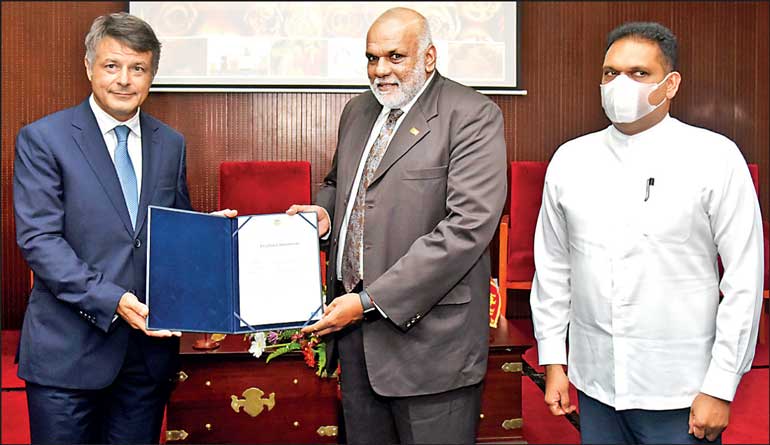Friday Dec 12, 2025
Friday Dec 12, 2025
Thursday, 28 April 2022 00:00 - - {{hitsCtrl.values.hits}}

Handing over the Ceylon Cinnamon GI Registration Certificate by European Union Ambassador in Sri Lanka and Maldives Denis Chaibi (left) to EDB Chairman/Chief Executive Suresh de Mel. Trade and Samurdhi Development Minister Shehan Semasinghe looks on
By Charumini de Silva
Marking a milestone, the European Union yesterday officially handed over Sri Lanka’s first-ever Geographical Indication (GI) certificate and status for Ceylon Cinnamon to the Export Development Board (EDB).
Sri Lanka’s quest for GI status for Ceylon Cinnamon was received from the EU Commission, following a painstaking, decade-long, arduous endeavour led by the EDB under the Ministry of Trade with the support of numerous public and private stakeholders.
The much-needed technical assistance from the UNIDO, delegation of the EU to Sri Lanka and the World Trade Organisation (WTO) and certain financial assistance granted by the Common Fund for Commodities, based in the Netherlands were all part of the landmark accomplishment.
EU Ambassador Denis Chaibi said the landmark accomplishment of Sri Lanka receiving the GI status resembles the true potential of the country.
“Sri Lanka has all the fundamentals in place. With the GI status for Ceylon Cinnamon we must now try to build on it, to increase the export income and empowering people engaged in the sector,” he added.
The Ambassador said the GI also preserves the country’s history and its people.
“Sri Lanka’s history is full and runs back to over 2,500 years. Ceylon Cinnamon more value than you’ll think. We want to see how Sri Lanka could make something that the everyone in the world wants using this incredible Ceylon Cinnamon,” he added.
He insisted that Sri Lanka should now work on its story or the brand which is based on the civilisation, beauty and its wealth.
“In the case of Ceylon Cinnamon, it is an endorsement of quality and an acknowledgement of the long tradition and rich history behind the production of this internationally renowned spice. It all depends now how we sell our Ceylon Cinnamon story to the world. In doing so Sri Lanka should focus on high social and Labour standards, civilisation, beauty, wealth, permanent contact with EU – the second largest export market,” he said.
The Ambassador also expressed his overwhelming satisfaction of EU in being part of this milestone.
Trade Minister Shehan Semasinghe said the enhanced competitive position of Ceylon Cinnamon in the EU market will have a positive impact in terms of an increased in exports from Sri Lanka, higher income and employment generation across the cinnamon value chain, benefiting about 30,000 stakeholders involved in cinnamon production and processing.
Sri Lanka is the world’s largest producer and exporter of cinnamon accounting for 90% of the global market share. Although there are many varieties of cinnamon, Ceylon Cinnamon is pure and considered superior due to its delicate taste and properties that contribute to many health benefits. Last year, Sri Lanka exported $ 230 million.
EDB Chairman Suresh de Mel said the GI status for Ceylon Cinnamon came is as a silver lining to the dark economic cloud Sri Lanka is faced with at present.
“GI status for Ceylon Cinnamon is a national breakthrough for our economy. It will give us competitive advantage for market differentiation and a better value proposition for our products. This competitive advantage in the EU market is a great opportunity for us to increase Sri Lanka’s exports and earn foreign exchange,” he added.
He also said it will benefit thousands of livelihoods in rural agricultural communities that are engaged in Ceylon Cinnamon production and processes.
Objection was raised by the competing countries to block the granting of GI status by the EU Commission to Sri Lanka for Ceylon Cinnamon, however, the EDB, with the support and encouragement of the multiple stakeholders, persevered against all the odds to realise this landmark accomplishment.In this breakthrough mission, the EDB was ably supported by Foreign Ministry, Department of Commerce, National Intellectual Property office, the Department of Export Agriculture, Spice Council and the Spices and Allied Products Producers’, Traders’ Association (SAPPTA).
“We have passed a long journey in obtaining GI for Ceylon Cinnamon. In 2009, followed by branding of Pure Ceylon Cinnamon, the EDB started the journey to secure registration of GI for Ceylon Cinnamon in the EU. Obtaining GI representing the whole country is a significant achievement and GI is beneficial to all stakeholders representing the cinnamon supply chain. Further, special focus can be given on rural development through Ceylon Cinnamon GI certification,” de Mel said.
The EDB Chief also called on cinnamon growers, processors, and exporters to use the PGI logo and attract high quality, value added and premium markets in future.
As part of obtaining the GI status, the Ceylon Cinnamon Geographical Indication Association (CCGIA) was established representing all the stakeholders in the cinnamon industry in the country. The responsibility of the CCGIA is to implement an internal control mechanism to monitor their members meeting the specifications stated in the GI specification document.
The participants within the cinnamon supply chain need to be registered/obtain the membership of the CCGIA to export Ceylon Cinnamon to the EU region under the ‘Ceylon Cinnamon’ name.
Last month the Parliament also approved the Intellectual Properties Act No. 36 of 2003, with the provisions to establish a comprehensive and definitive legal framework for the registration of geographical indications in Sri Lanka, which paved the way to secure GI status for Ceylon Cinnamon.
Former Trade Minister Bandula Gunawardena in October 2020 submitted this proposal to the Cabinet to advise the Legal Draftsman to draft a bill to amend the Act.
Pix by Ruwan Walpola